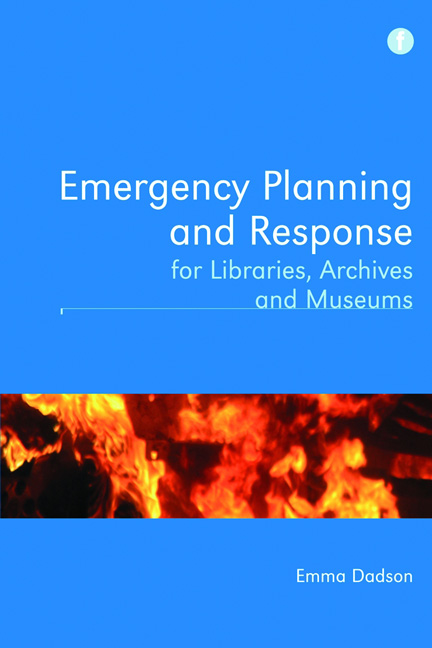Book contents
- Frontmatter
- Contents
- Foreword
- Preface
- Acknowledgements
- 1 Introduction
- 2 Case studies
- 3 Roles and responsibilities
- 4 Incident control
- 5 Planning the recovery operation
- 6 Collections salvage
- 7 Supplementary content
- 8 Dealing with the building
- 9 Business continuity
- 10 Ensuring the plan's efficacy
- 11 Conclusion
- Bibliography and references
- Index
3 - Roles and responsibilities
Published online by Cambridge University Press: 08 June 2018
- Frontmatter
- Contents
- Foreword
- Preface
- Acknowledgements
- 1 Introduction
- 2 Case studies
- 3 Roles and responsibilities
- 4 Incident control
- 5 Planning the recovery operation
- 6 Collections salvage
- 7 Supplementary content
- 8 Dealing with the building
- 9 Business continuity
- 10 Ensuring the plan's efficacy
- 11 Conclusion
- Bibliography and references
- Index
Summary
Introduction
This chapter is designed to help readers work out how best to organize their team to manage the various activities that need to be completed if a plan is activated. If there is a major emergency, the tasks required for completion will broadly be the same regardless of the type of the institution: restoring the building and its contents, resuming services, and taking care of staff. Although the tasks are the same, one size does not fit all. Differences will emerge related to the varying sizes of institution and their staff, and differences in emphasis given to salvage of collections and business continuity. Some organizations have certain activities, particularly facilities and press functions, completed by colleagues in other departments. Each institution must work out how best to divide the tasks that are required for completion.
The roles and responsibilities outlined here must be adapted when formulating or reviewing your emergency plan: the dissemination of the responsibilities will vary. The detail of how to approach this is discussed throughout this book. Practical experience indicates that giving individuals a clear notion of their role and what they are required, able and authorized to do makes response much quicker and clearer. Referring back to the template guidance referred to in Figure 1.4 (page 12), this chapter provides information on how to formulate your own Emergency Management Team and generic advice on what their roles should entail.
Emergency response activities
Consider an emergency such as a burst pipe, causing damage in a public area of a library across two floors. What will need to be organized in order to respond effectively to this incident? Someone will need to deal with the source of the water itself and try to isolate it. Services may be interrupted as people cannot use the affected area, rendering some parts of the collection inaccessible and limiting workspace. Items within your collection are becoming damaged and need to be protected.
What about a power cut? What demands would that place on an archive? IT would be down. How long can services run on emergency lighting? Can a retrieval service operate? Is there any impact on the collections as a result of the sudden cessation of the environmental control system?
- Type
- Chapter
- Information
- Publisher: FacetPrint publication year: 2012



